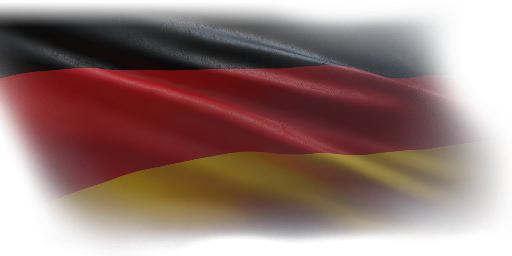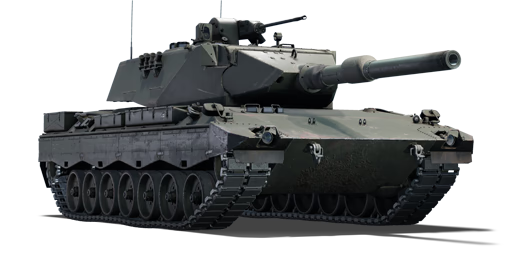




The forerunner to the Leopard 2 was in many ways a return to form of what the Leopard 1 was designed as: the sacrifice of armour for incredible speed and firepower. The Leopard 2K started life as a project after the US-German MBT/KPz-70 program fell apart in 1970, as an urgent program to replace the now aging Leopard 1. There had been prior attempts at modernization and development, such as the "vergoldeter Leopard" (gilded Leopard) program in 1967 which aimed to install an autoloader and coaxial autocannon to the Leopard 1, and the Bundeswehr decided to re-use parts of this development in a series of vehicles nicknamed "Keiler", or "tusker". This resulted in two separate vehicles being prototyped and tested: The Leopard 2FK, which was armed with a gun/launcher system similar to the KPz-70's, and the Leopard 2K, armed with a smoothbore 105 mm cannon. The Bundeswehr declared the 2K as the superior design in 1971, and development of the 2FK was abandoned as a result.
There were 16 Leopard 2K prototypes produced (the 17th hull was cancelled), the first 10 equipped with the 105 mm smoothbore gun and the later 6 with the 120 mm smoothbore. These prototypes went through technical tests in between 1972 and 1975, but were ultimately held back due to development of the EMES-13 rangefinder stalling and the MLC 50 requirements (roughly 47.5 tons), which were insufficient in providing adequate protection against enemy tank fire. Unfortunately for the Leopard 2K, the lessons learned during the Yom Kippur War in 1973 alerted the Bundeswehr to the fact that armour was still very much relevant in tank engagements, which led to the easing of restrictions on weight to MLC 60 (55 tons). Coupled with the EMES-13 system finishing development, development moved on to produce what became the Leopard 2AV, while the Leopard 2K was rejected due to its perceived inadequate armour against potential threats, ending its development.
Introduced in Update 1.77 "Advancing Storm", the Leopard 2K is what the Leopard 2 could have been, following up on the Leopard 1's design choices in low armour in exchange for near unmatchable mobility and firepower. A titular glass cannon, the Leopard 2K is not heavily armoured and can be penetrated almost anywhere by contemporary tank rounds. However, what the 2K lacks in armour it more than makes up for in the other two areas; speed and firepower. The 120 mm smoothbore cannon has enough penetration to simply point and click at the upper plate of very common enemies at this BR such as the T-72AV (TURMS-T), and coupled with the laser rangefinder can accurately fire shells at extreme ranges with adequate zoom on its optics. The vehicle is also equipped with an Rh202 autocannon on the roof, which is operated by the gunner, which lets the vehicle still fire the gun even when on 2 crew. The autocannon has a high traverse rate and has a high rate of fire, and can engage both enemy light vehicles, barrels, tracks and aircraft ubiquitously. The mobility is the standout feature of this tank, with an eye-watering 30 hp/t power-to-weight ratio that lets it barrel across the map faster than almost anyone else. Even the extremely mobile XM-1 (GM) is just shy of 30 at 28.9 hp/t, and outside of vehicles such as the VT1-2 with its horrifying 50.6 hp/t it can outpace just about all MBTs it can face in the positioning game. This combination of the 20 mm autocannon, high damaging 120 mm smoothbore cannon and mobility that is almost unmatched by any other means the Leopard 2K is a beast of a tank that performs best when used to the extreme, going from firing position to firing position and always being unexpected.
| Ammunition | Type | Armor penetration (mm) at a distance: | |||||
|---|---|---|---|---|---|---|---|
| 10 m | 100 m | 500 m | 1000 m | 1500 m | 2000 m | ||
| HEATFS | 480 | 480 | 480 | 480 | 480 | 480 | |
| APFSDS | 393 | 390 | 384 | 376 | 367 | 359 | |
| APFSDS | 408 | 407 | 400 | 393 | 385 | 377 | |
| Belt | Belt filling | Armor penetration (mm) at a distance: | |||||
|---|---|---|---|---|---|---|---|
| 10 m | 100 m | 500 m | 1000 m | 1500 m | 2000 m | ||
| HEFI-T/HVAP-T | 57 | 52 | 37 | 24 | 15 | 10 | |
| Belt | Belt filling | Armor penetration (mm) at a distance: | |||||
|---|---|---|---|---|---|---|---|
| 10 m | 100 m | 500 m | 1000 m | 1500 m | 2000 m | ||
| AP/T | 13 | 12 | 7 | 3 | 2 | 0 | |












Mobility | |
|---|---|
Protection |
|---|
Firepower | ||
|---|---|---|